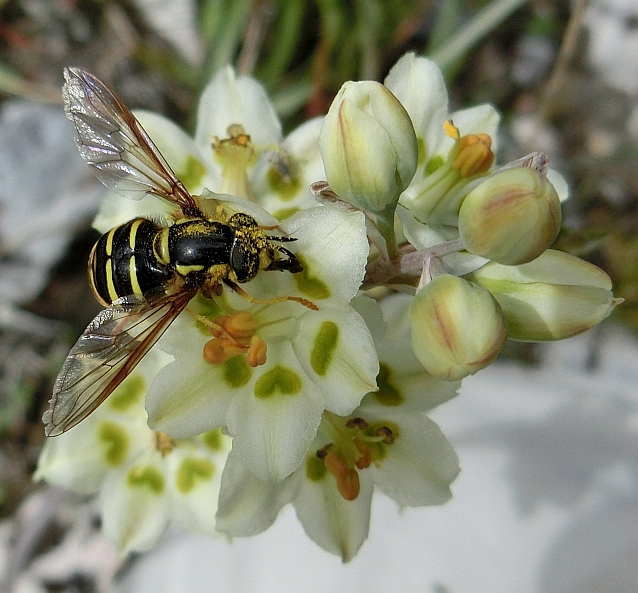Diverse flies (Diptera) likely pollinate an alpine death camas, Anticlea elegans (Melanthiaceae)
DOI:
https://doi.org/10.26786/1920-7603(2024)803Keywords:
protandry, Syrphidae, Tenthredinidae, timberline, ZigadenusAbstract
Several populations of a species of death camas (Anticlea elegans) (Melanthiaceae) were found growing and flowering above treeline in the remote Lemhi Mountains of southeastern Idaho USA. The predominant floral visitors were flies representing four families, particularly the Syrphidae. Many individual flies bore visible loads of Anticlea pollen. Various native bees were seen foraging in the locale, but all visited flowers other than Anticlea. The flies, as well as ants, fed from the tepal nectaries. Despite the plant’s common name, no foragers appeared to be impaired by imbibing its nectar. High in a neighbouring mountain range, A. elegans was being used as a trysting site by numerous Tenthredo sawflies. This is the first report of floral visitors to any Anticlea and among the first for any wildflower population above treeline in the vast US Intermountain West.
References
Bloomquist JR (1996) Ion channels as targets for insecticides. Annual Review of Entomology 41:163–190. https://doi.org/10.1146/annurev.en.41.010196.001115 DOI: https://doi.org/10.1146/annurev.ento.41.1.163
Cane JH (2018) Co-dependency between a specialist Andrena bee and its death camas host, Toxicoscordion paniculatum. Arthropod-Plant Interactions 12:657–662. https://doi.org/10.1007/s11829-018-9626-9 DOI: https://doi.org/10.1007/s11829-018-9626-9
Cane JH, Gardner DR, Weber M (2020) Neurotoxic alkaloid in pollen and nectar excludes generalist bees from foraging at death-camas, Toxicoscordion paniculatum (Melanthiaceae). Biological Journal of the Linnean Society 131:927–935. https://doi.org/10.1093/biolinnean/blaa159 DOI: https://doi.org/10.1093/biolinnean/blaa159
Davis MA (1981) The effects of pollinators, predators, and energy constraints on the floral ecology and evolution of Trillium erectum. Oecologia 48:400–406. https://doi.org/10.1007/BF00346501 DOI: https://doi.org/10.1007/BF00346501
Hitchcock JD (1959) Poisoning of honey bees by death camas blossoms. American Bee Journal 99:418–419.
Irwin RE (2001) Field and allozyme studies investigating optimal mating success in two sympatric spring-ephemeral plants, Trillium erectum and T. grandiflorum. Heredity 87:178–189. https://doi.org/10.1046/j.1365-2540.2001.00896.x DOI: https://doi.org/10.1046/j.1365-2540.2001.00896.x
Jacquemyn H, Brys R (2008) Density-dependent mating and reproductive assurance in the temperate forest herb Paris quadrifolia (Trilliaceae). American Journal of Botany 95:294–298. https://doi.org/10.3732/ajb.95.3.294 DOI: https://doi.org/10.3732/ajb.95.3.294
Kato Y, Araki K, Ohara M (2009) Breeding system and floral visitors of Veratrum album subsp. oxysepalum (Melanthiaceae). Plant Species Biology 24:42–46. https://doi.org/10.1111/j.1442-1984.2009.00231.x DOI: https://doi.org/10.1111/j.1442-1984.2009.00231.x
Kearns CA (1992) Anthophilous fly distribution across an elevation gradient. American Midland Naturalist 127:172–182. https://doi.org/10.2307/2426332 DOI: https://doi.org/10.2307/2426332
Larson BMH, Kevan PG, Inouye DW (2001) Flies and flowers: taxonomic diversity of anthophiles and pollinators. Canadian Entomologist 133:439–465. https://doi.org/10.4039/Ent133439-4 DOI: https://doi.org/10.4039/Ent133439-4
Lefebvre V, Villemant C, Fontaine C, Daugeron C (2018) Altitudinal, temporal and trophic partitioning of flower-visitors in Alpine communities. Scientific Reports 8:4706. https://doi.org/10.1038/s41598-018-23210-y DOI: https://doi.org/10.1038/s41598-018-23210-y
Majak W, McDiarmid RE, Cristofoli W, Sun F, Benn M (1992) Content of zygacine in Zygadenus venenosus at different stages of growth. Phytochemistry 31:3417–3418. https://doi.org/10.1016/0031-9422(92)83697-W DOI: https://doi.org/10.1016/0031-9422(92)83697-W
Miranda GFG, Young AD, Locke MM, Marshall SA, Skevington JH, Thompson FC (2013) Key to the genera of Nearctic Syrphidae. Canadian Journal of Arthropod Identification 23 [online] URL: https://cjai.biologicalsurvey.ca/articles/mylmst-23/ (accessed 18 April 2024).
Müller H (1880) The fertilisers of alpine flowers. Nature 21:275. https://doi.org/10.1038/021275d0 DOI: https://doi.org/10.1038/021275d0
Niu Y, Gong Q, Peng D, Sun H, Li Z (2017) Function of male and hermaphroditic flowers and size-dependent gender diphasy of Lloydia oxycarpa (Liliaceae) from Hengduan Mountains. Plant Diversity 39:187–193. https://doi.org/10.1016/j.pld.2017.06.001 DOI: https://doi.org/10.1016/j.pld.2017.06.001
Perepelova LI (1949) Effect of hellebore pollen on bees. Works. vet. Sect. Lenin Acad. Agric. Sci. Session 27:55–65.
Sommaggio D, Zanotelli L, Vettorazzo E, Burgio G, Fontana P (2022) Different distribution patterns of hoverflies (Diptera: Syrphidae) and bees (Hymenoptera: Anthophila) along altitudinal gradients in Dolomiti Bellunesi National Park (Italy). Insects 13:293. https://doi.org/10.3390/insects13030293 DOI: https://doi.org/10.3390/insects13030293
Tepedino VJ, Knapp AK, Eickwort GC, Ferguson DC (1989) Death camas (Zigadenus nuttallii) in Kansas: pollen collectors and a florivore. Journal of the Kansas Entomological Society 62:411–412.
Tomimatsu H, Ohara M (2002) Effects of forest fragmentation on seed production of the understory herb Trillium camschatcense. Conservation Biology 16:1277–1285. https://doi.org/10.1046/j.1523-1739.2002.00412.x DOI: https://doi.org/10.1046/j.1523-1739.2002.00412.x
Vance NC, Bernhardt P, Edens RM (2004) Pollination and seed production in Xerophyllum tenax (Melanthiaceae) in the Cascade Range of central Oregon. American Journal of Botany 91:2060–2068. https://doi.org/10.3732/ajb.91.12.2060 DOI: https://doi.org/10.3732/ajb.91.12.2060
Vansell GH, Watkins WG (1933) A plant poisonous to adult bees. Journal of Economic Entomology 26:168–170. https://doi.org/10.1093/jee/26.1.168 DOI: https://doi.org/10.1093/jee/26.1.168
Warren SD, Harper KT, Booth GM (1988) Elevational distribution of insect pollinators. The American Midland Naturalist 120:325–330. https://doi.org/10.2307/2426004 DOI: https://doi.org/10.2307/2426004
Zomlefer WB, Judd WS (2002) Resurrection of segregates of the polyphyletic genus Zigadenus s.l. (Liliales: Melanthiaceae) and resulting new combinations. Novon 12:299–308. https://doi.org/10.2307/3392971 DOI: https://doi.org/10.2307/3392971
Zych M, Goldstein J, Roguz K, Stpiczyńska M (2013) The most effective pollinator revisited: pollen dynamics in a spring-flowering herb. Arthropod-Plant Interactions 7:315–322. https://doi.org/10.1007/s11829-013-9246-3 DOI: https://doi.org/10.1007/s11829-013-9246-3

Downloads
Published
How to Cite
Issue
Section
License
Copyright (c) 2024 James H Cane

This work is licensed under a Creative Commons Attribution 4.0 International License.











